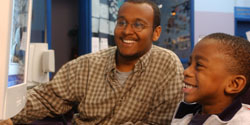
Graphic Organizers | Co-operative Learning | Feedback | Recognition | Questioning | Modelling | Managing ICT

Tapping Prior Knowledge
Teaching and Learning Strategies
Strategies to Tap Prior Knowledge
Written Activities |
About Tapping Prior Knowledge
For a learner, new content can be overwhelming. There are new vocabulary words, ideas, and concepts that others seem to understand easily or have experienced before. Teachers can help their learners make the transition from the unfamiliar by tapping learners’ prior knowledge. Research shows that we can jump-start learning by accessing pre-existing attitudes, experiences, and knowledge and bridge the gap between what is being taught and what is already known.
Teachers can also use prior knowledge to make teaching and learning more meaningful. Many researchers (Peshkin, 1992; Protheroe & Barsdate, 1992; and Lee, 1992) emphasize the importance of incorporating a learner's cultural background into the curriculum. As the world changes, learners must learn to understand and appreciate the experiences and contributions of people from different backgrounds. A culturally-responsive education links curriculum, teaching and learning, and assessment to the learners' experiences, language, and culture, in other words, to their prior knowledge.
Additionally, this strategy defines a proper starting place for teaching and the sequence of learning activities. As stated by educational psychologist David Ausubel, “The most important single factor influencing learning is what the learner already knows.”
Make it Happen in Your Classroom
Exercises to access prior knowledge can be used at any grade level, with any learning area / subject. Prior knowledge is the proper entry point for teaching and learning because it builds on what is already known, supports comprehension, and makes sense of new learning (Kujawa and Huske, 1995). Tapping learners’ prior knowledge is an effective way to start a new section or lesson and an even better way to get learners involved right from the start with classroom projects. Referring back to this knowledge throughout a project will keep learners engaged in their learning and keep the material relevant.
Examples Across the Curriculum
From simply asking questions aloud to formally using a journal to document learners' prior knowledge, there are a wide range of activities teachers can use. The following examples can be used across the curriculum and at any grade level.
Written Activities
Activities that prompt learners to write and reflect about what they already know about new content. These include quick writes, journals, and learning logs.
Know-Wonder-Learn Charts (K-W-L)
A teaching and learning technique used to activate learners’ prior knowledge, set goals, and record new knowledge gleaned from a project or unit of learning.
Thinking Activities
Activities that tap learners’ thinking by giving them an opportunity to make predictions, list and rank ideas, and make analogies based on their prior knowledge.
Discussions
Teacher to learner and whole class discussions activate learners’ prior knowledge by providing opportunities to orally share ideas and discuss opinions.
References
Kujawa, S., & Huske, L. (1995). The Strategic Teaching and Reading Project guidebook (Rev. ed.). Oak Brook, IL: North Central Regional Educational Laboratory.
Lee, C. D. (1992, February). Literacy, cultural diversity, and instruction. Education and Urban Society, 24(2), 279-291.
Peshkin, A. (1992). The relationship between culture and curriculum: A many fitting thing. In P.W. Jackson (Ed.), Handbook on research on curriculum, (pp. 248-267). New York: Macmillan.
Protheroe, N. J., & Barsdate, K. J. (1992, March). Culturally Sensitive Instruction. Streamlined Seminar, 10(4), 1-4.
